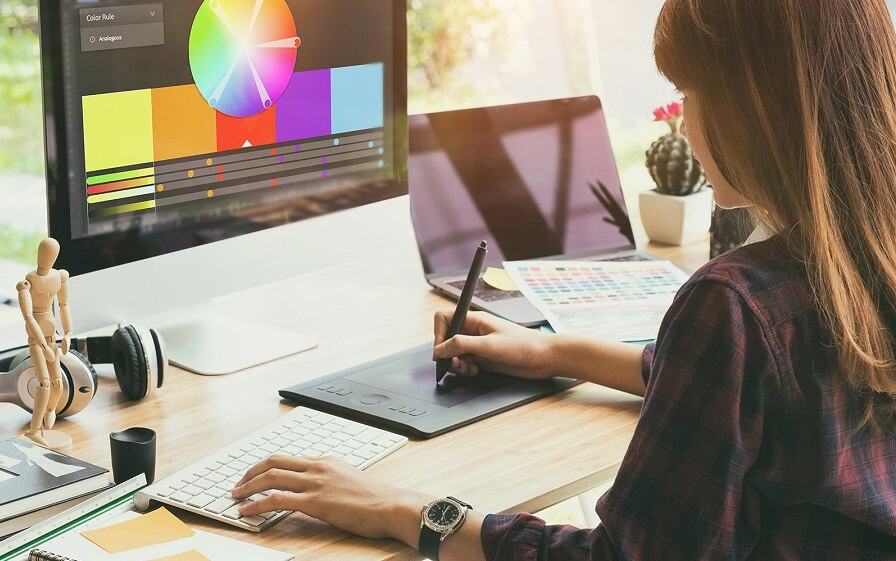Welcome aspiring designers! Buckle up, because we’re diving into the essential building blocks of graphic design: color theory, typography, and layout. Mastering these elements is the foundation for crafting visually stunning and impactful designs that resonate with your audience.
Color Theory: A Spectrum of Emotion
Colors are powerful. They influence how we perceive a design, evoke emotions, and guide the viewer’s eye. Understanding color theory equips you to make deliberate color choices that align with your design’s message and target audience. Let’s explore some key concepts:
- The Color Wheel: Your Color Mixing Guide: Imagine a rainbow shaped like a circle. This is the color wheel, a fundamental tool for understanding color relationships. It organizes colors based on how they’re created:
- Primary Colors: The rockstars – red, yellow, and blue – are the building blocks from which all other colors are derived.
- Secondary Colors: Mixing primary colors in equal parts creates secondary colors like green, orange, and purple.
- Tertiary Colors: Combining a primary and a secondary color creates tertiary colors, offering a wider spectrum of options.
- Color Psychology: Unveiling the Emotional Impact: Different colors have a profound impact on how we feel. Red is associated with excitement and energy, while blue conveys calmness and trust. Understanding these associations allows you to choose colors that support your design’s message. For instance, a website selling children’s toys might use bright, playful colors to evoke feelings of joy and excitement, while a financial services company might opt for more calming blues and greens to convey trust and stability.
- Color Schemes: Crafting Cohesive Palettes: Color schemes dictate how colors work together in a design. Popular schemes include:
- Complementary Colors: Colors opposite each other on the color wheel create a vibrant contrast, ideal for grabbing attention in website headers or posters.
- Analogous Colors: Colors next to each other on the color wheel offer a harmonious and cohesive feel, often used for creating calming and aesthetically pleasing backgrounds.
- Triadic Colors: Three colors evenly spaced on the color wheel create a dynamic and bold composition, well-suited for modern and eye-catching designs.
Typography: The Art of Storytelling with Type
Typography goes beyond just choosing a font. It’s about using text strategically to convey information, establish brand identity, and enhance the visual appeal of your design.
- Font Families and Anatomy: Demystifying Text Design: Fonts come in families that share similar characteristics. Learn about serif vs. sans-serif fonts, understanding the impact of serifs (small decorative strokes) on readability. Explore basic type anatomy, like baseline (the line on which letters sit), x-height (the height of lowercase letters without ascenders or descenders), and kerning (spacing between letters) – all crucial for ensuring proper text rendering.
- Choosing the Right Font: Matching Message with Style: Consider the message and target audience when selecting a font. Opt for clear and legible fonts for body text in web design, while display fonts can be more decorative and playful for headings or logos. For example, a legal document might use a classic serif font like Times New Roman for a sense of formality, while a children’s book might use a more whimsical and playful display font.
- Hierarchy and Readability: Guiding the Viewer’s Eye: Use font size, weight, and color to create a visual hierarchy, guiding the viewer’s eye to the most important information. Headings should be larger and bolder than body text, creating a clear hierarchy and improving readability.
Layout: The Art of Arrangement
Layout refers to the arrangement of elements on a page or screen. A well-considered layout creates a sense of balance, guides the viewer’s visual journey, and ultimately enhances the user experience.
- Rule of Thirds: A Simple Composition Guide: Imagine dividing your design area into a 3×3 grid. Placing key elements at the intersections or along the lines creates a more natural and visually pleasing composition. This is a popular rule of thumb for photographers and graphic designers alike.
- White Space (Negative Space): Your Friend in Design: Whitespace, or negative space, is the empty area around your design elements. It creates visual breathing room and emphasizes the importance of content. Don’t be afraid of whitespace! It can be a powerful design tool.
- Balance and Asymmetry: Finding Harmony: Balance doesn’t have to mean perfect symmetry. Symmetrical layouts can be formal and elegant, while asymmetrical layouts can be more dynamic and engaging. Experiment to find the right balance for your design.
- Proximity: Grouping for Clarity: Grouping related elements creates a sense of connection and improves readability. For instance, group a product image with its description on an e-commerce website, or cluster related navigation buttons for a more intuitive user experience.
Remember: Mastering these design fundamentals takes dedication and practice. Experiment with different color combinations, fonts, and layouts to see how they affect your designs. Analyze existing designs you admire, deconstructing their use of color theory, typography, and layout. Don’t be afraid to get creative and explore!

